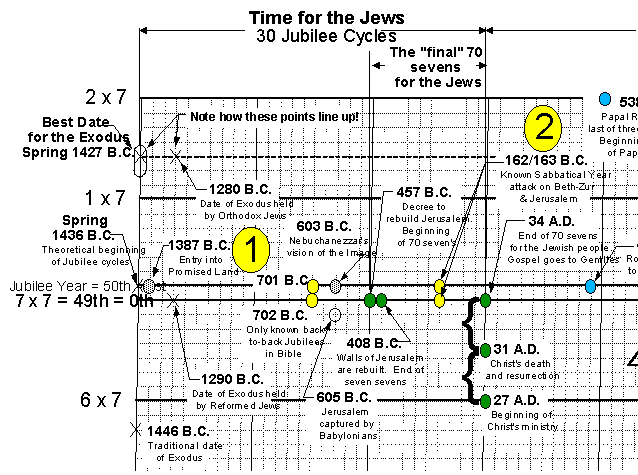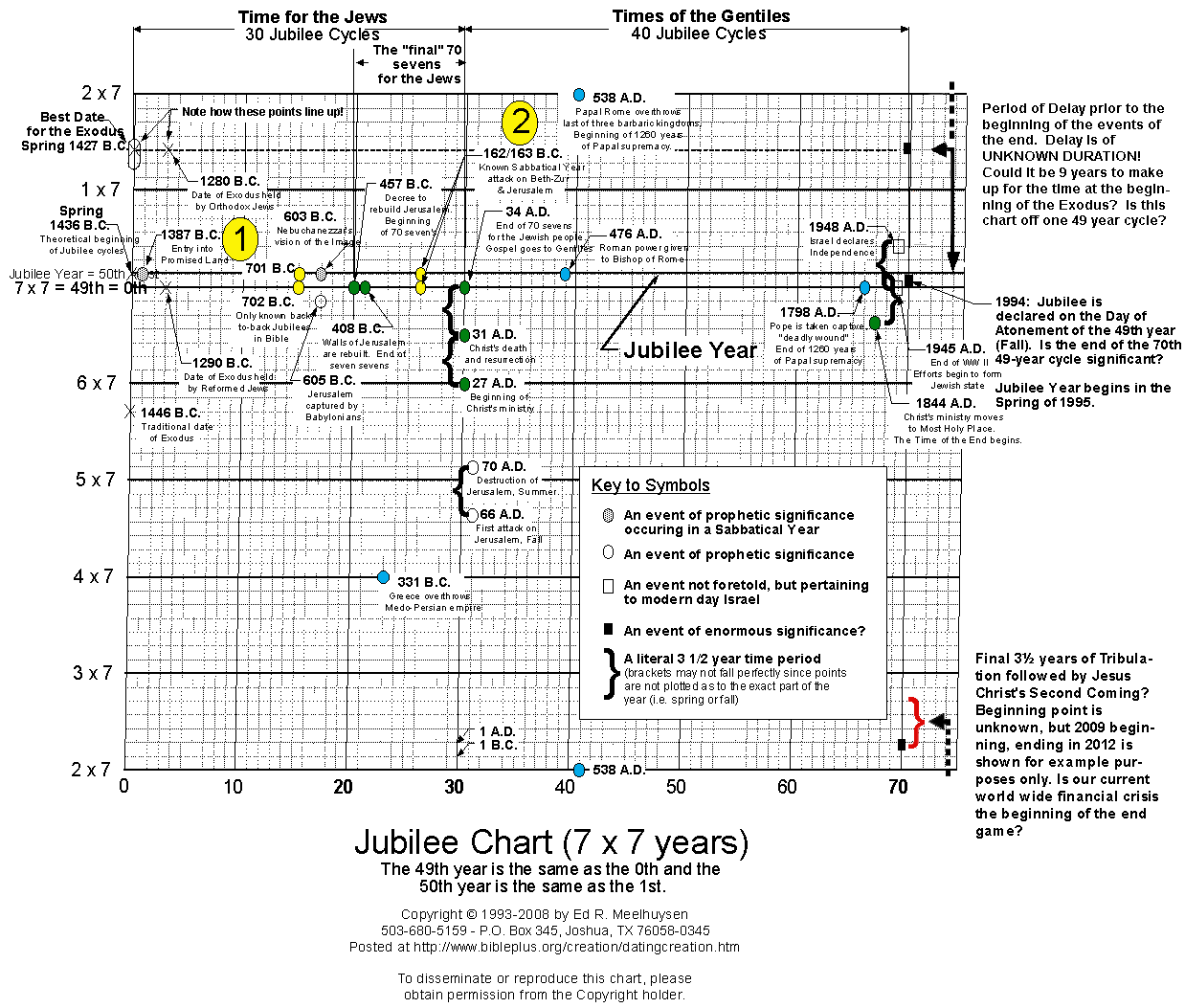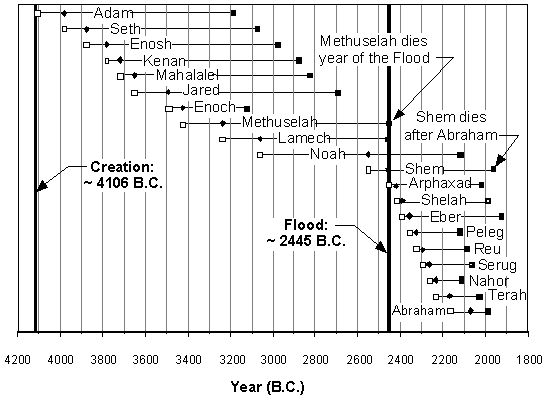
In 1650, James Ussher assembled a chronology of Old Testament events. From them he concluded that the Creation of the world took place in approx. 4004 B.C. This view is commonly held by many Christians. However, it is difficult to substantiate this date, but it has served as an adequate estimate of the date of Creation for some time. However, is it possible to do a better job of calculating the date? And if a more accurate date is determined, can we draw some interesting inferences from it that would apply to our day and time? I believe there is!
The Jewish people currently use a calendar that they feel is based on the date of the Creation of the world in 3761 B.C., some 5753 years ago. Is this date correct or even closer than James Ussher's date?
Based upon the genealogy of the patriarchs as contained in Scripture, once one has determined the date of the Exodus of the Israelites from Egypt, one should be able to arrive at a reasonably close determination for the Date of Creation.
Several dates posed as the date of the Exodus include 1290 B.C. held by the Reformed Jews and 1280 B.C. held commonly by the Orthodox Jews.
As more ancient artifacts and manuscripts are rediscovered, dates of important events have been modified and their accuracy improved. Most archaeologists now place the date of the Exodus around 1446 B.C., during the reign of Amenophis II (1450 - 1426 B.C.), a pharaoh of Egypt. This would place the Jewish calendar off by around 166 years or so.
However, any proposed date for the Exodus must be coordinated with the start of the Jubilee and Sabbatical Years calendar, a time keeping system instituted by God (see Exod. 12:2 and Lev. 25). Let's see if we can determine an even more accurate date.
A Sabbatical cycle consisted of 7 years with the last year being a Sabbatical Year. During this 7th or Sabbatical Year, no farming was to be done. The land was to have its rest.
God also instituted a Jubilee cycle, a cycle of seven Sabbatical cycles for a total of 49 years. The 50th year (which was the same as the 1st year) of the 49 year jubilee cycle was also a Sabbatical Year during which again no farming was to be done. This 50th year was called the Year of Jubilee. People were to return to their ancestral homelands, and all land was to be returned to the original titleholders as determined at the time of entrance into the Promised land of Canaan. Jubilee or freedom for the land was declared on the Day of Atonement in the 49th year (Lev. 25:9).
For those who may need further understanding of what a Sabbatical Year or a Year of Jubilee is, I suggest studying Leviticus chapter 25. Click here to view the texts.
There are only several dates recorded that are known to be Jubilee or Sabbatical Years.
In Isaiah 37:30, God declares back-to-back Sabbatical Years, indicating the 49th and 50th years of the 49 year jubilee cycle.
This occurred in conjunction with Sennacherib, king of Assyria's siege on Jerusalem. This has been dated between 701-703 B.C.
In 1 Maccabees 6:48, 49, in the Apocrypha, a siege is noted that occurred during a Sabbatical Year.
The date given in the verse footnotes for this siege is 162 B.C. or possibly 163 B.C. (p. 236, The Oxford Annotated Apocrypha, RSV)
If we plot these pairs of dates (701, 702 B.C. and 162, 163 B.C.) on a graph of 49 year cycles, then we should expect these two sets of dates to line up. See the dates associated with the large circled "1" and "2" on the chart following. Since the points fortunately do line up, it provides strong evidence that we have found back-to-back Sabbatical Years indicating the 49th and 50th years of the 49 year Jubilee cycle. Furthermore, we note that the dates of 1427 B.C. and 1280 B.C. line up perfectly, being consistent with the fact that the Orthodox Jews had maintained a knowledge of where the Sabbatical years were in the ancient past. The importance of this will become apparent shortly.
Understanding the Jubilee Chart Construction

Additionally, the precision with which other significant prophetic dates fall on Sabbatical Years/Jubilee Years in the calendar confirms our find of the 49th and 50th years and thus the placement of the other Sabbatical Years. No other orientation or matching up would result in as many dates falling on Sabbatical/Jubilee Years.
Beside the above date pairs, ALL prophecies containing prophetic dates interpreted using the "day for a year" principle (see Num. 14:33, 34; Ezek. 4:5, 6) have either a beginning or end point on a Sabbatical Year! These include the:
| 1 | 70 sevens or 490 year prophecy of Dan. 9:24 (457 B.C. to 34 A.D.) including the seven sevens (408 B.C.), and the sixty-ninth seven (27 A.D.) The date for the decree to "restore the walls of Jerusalem" by Artaxerxes which began the 70 sevens of Daniel 9:24 and Ezra's journey to Jerusalem was accurately determined to be entirely in 457 B.C. (The Chronology of Ezra 7, Sigfried Horn, 1970). Each of the dates of this prophecy are shown as green dots in the chart, along with the 1844 ending date for the 2300 year prophecy mentioned next. |
| 2 | 2300 day (year) prophecy of Dan. 8:14 (457 B.C. to 1844 A.D.). At that time, Christ moved His intercessory ministry from the Holy Place in the heavenly tabernacle to the Most Holy Place. |
| 3 | Time, times and half a time prophecy (3½ prophetic years, 1260 literal years) of the little horn power (Papal Rome) after it had overthrown three of the ten kings of Dan. 7:24 (538 A.D. to 1798 A.D.) |
In fact, ALL of the above dates mentioned fall on Sabbatical Years, with the exception of 1844 A.D. (But there is additional significance to its location which won't be discussed in this paper.)
Moreover, even some dates relevant to the transfer of power between the major world empires as recorded in Daniel fall on Sabbatical Years! These include the:
| 4 | Rise of the Grecian empire as recorded in Dan. 8:20, 21 and other locations. The Greeks overthrew the Medo-Persian empire in 331 B.C. |
| 5 | Rise of the little horn power and the beginning of the overthrow of the three horns. Dan. 7:24, 25. (476 A.D.) |
| 6 | The solidification of power of the little horn power, the Papacy or Holy Roman Empire (538 A.D.). Symbolized in prophecy as the little horn power finishing uprooting the three other horns (Dan. 7:8, 24). |

When I first plotted out these dates and saw the precision with which the dates for these prophetic events fell on Sabbatical Years, I was filled with a greater sense of awe of God. There was order and precision beyond coincidence, evidence for a master plan.
For God, there is an appointed time for everything. Asaph, one of the psalmists wrote:
Further Scripture supports this:
Interestingly enough, the phrase appointed time is used 22 times in the New International Version of the Bible. And the word time or times is used 888 times. God is a God of order. He sets the appointed times by His will and power.
Now that we can feel confident that we have found the Jubilee calendar system as instituted by God, we can more accurately determine the date of the Exodus.
The year when the Israelites partook of the food of Canaan land (food which they had not planted) completed the first jubilee cycle, even though it was a partial one.
This "Jubilee" for the Israelites was a forerunner, a type, of the great Jubilee when we will cross over the Jordan of the great tribulation and eat the produce of the heavenly Canaan land.
Thus according to the Jubilee chart, the Israelites would have entered Canaan and celebrated their first Jubilee in the Spring of 1387 B.C.
Since the Israelites spent around 40 years wandering in the wilderness, going back 40 years places the date of the Exodus around 1427 B.C. (1387 B.C. + 40 years = 1427 B.C.) This correctly falls during the aforementioned reign of Amenophis II and in fact, it is possible that Amenophis II drowned along with many of his soldiers as he attempted to recapture the children of Israel as they passed through the Red Sea.
Now that we have established a fairly accurate date for the Exodus, we turn to the ages of the patriarchs as recorded in Scripture, and more specifically, Genesis chapters 5 and 11. At this point, we are faced with two more questions. Are the ages given in Scripture given using 1) inclusive reckoning, or 2) the more standard form as we use now? In other words, when it says that Adam was 130 years old when he had Seth, does it mean he was in his 130th year of life, or that he had passed his 130th birthday? The NIV translates the first age reference as:
A literal translation interprets the text as:
While the Hebrew term sheloshiym (Strong's 7970) is translated as thirty, it can also be translated as thirtieth for ordinal numbers. However, in the sentence structure we are studying, it appears to mean thirty as in one hundred and thirty. Thus we will take the text and those following at face value, i.e. that Adam was at least 130 years old when Seth was born, etc.
Given this then, we must take into consideration another factor that other calculations of the date of Creation have not taken into consideration. The son of a patriarch would rarely be born during the same month or on the same day as his father's birthday. In fact, the father could be anywhere from 1 day to nearly 12 months older than the age given in the Bible states. Common sense would dictate that if you had a large number of generations, that the age of a father at the birth of a son would be some age plus an average of 6 months or ½ a year. Neglecting this factor can produce an appreciable error. In fact, over the number of generations as recorded in Genesis, this error would be between 10 and 11 years. Therefore, the ages for the patriarchs shown below in the calculations reflect the additional ½ year average unless the Bible specifically indicates that the birth or event occurred on or around the exact birthday of the patriarch (i.e. Noah) or anniversary of an event (the migration into Egypt).
Taking the above information into consideration and using the above date of 1427 B.C. for the Exodus, the date of Creation would be around 4106 B.C. The Flood of Genesis chapters 6 - 9 would have began around 2445 B.C.

Methuselah, the grandfather of Noah could have known Adam quite well since they overlapped each other by over 200 years. Methuselah died around the year of the flood.
Abraham was around 53 years old when Noah died.
Shem, who was born 98 years before the flood, died 31 years after Abraham died.
The enormous intellect and memory capacity of the patriarchs and the extensive overlapping of their lives provide additional evidence that the Creation account as provided in Genesis chapter 1 is accurate. If a person did not believe what his father or those around him told him, he could go right to the source and find out the "rest of the story."
| Description | Years | Reference |
| Adam to Seth | 130.5 | Gen. 5:1-32 |
| Seth to Enosh | 105.5 | |
| Enosh to Kenan | 90.5 | |
| Kenan to Mahalalel | 70.5 | |
| Mahalalel to Jared | 65.5 | |
| Jared to Enoch | 162.5 | |
| Enoch to Methuselah | 65.5 | |
| Methuselah to Lamech | 187.5 | |
| Lamech to Noah | 182.5 | |
| Noah to Flood | 600.5 | Gen. 7:11 |
| Adam to Flood | ~1661.0 | years |
Gen. 7:11 is somewhat enigmatic. It could be interpreted to read "in the 600th year of Noah's life, on the 17th day of the second month of the calendar year" or "in the 600th year, second month, 17th day of Noah's life." I have seen it translated both ways. In the event the latter is correct, then the Noah to Flood span would be 600.2.
| Description | Years | Reference |
| Flood to Arphaxad | 2.5 | Gen. 11:10-32 |
| Arphaxad to Shelah | 35.5 | |
| Shelah to Eber | 30.5 | |
| Eber to Peleg | 34.5 | |
| Peleg to Reu | 30.5 | |
| Reu to Serug | 32.5 | |
| Serug to Nahor | 30.5 | |
| Nahor to Terah | 29.5 | |
| Terah to Abraham | 70.5 | |
| Abraham to Isaac | 100.5 | Gen. 21:5 |
| Isaac to Jacob | 60.5 | Gen. 25:26 |
| Jacob to Egypt | 130.5 | Gen. 47:9 |
| Egypt to Exodus | 430.0 | Exod. 12:41 |
| Flood to Exodus | 1018.0 | years |
| If Date of Exodus is: | 1427 B.C. | (Spring) |
| Then the Date of Flood | ~ 2445 B.C. | |
| and the Date of Creation | ~ 4106 B.C. |
I have taken Gen. 11:10 to read as "2 years after the flood waters began" or about one year after the flood waters receded. This would mean that Shem impregnated his wife shortly after coming out of the Ark. However, if the ancients considered the whole duration while Noah's family was in the ark as "the flood," the correct interpretation would be "two years after the flood waters receded and the family came out of the ark . . ." If the latter is correct, then the Flood (beginning) to Arphaxad span should be 3½ years, and the date of Creation is pushed back one additional year to around 4107 B.C.
Continue on to
DATING THE FALL OF MAN (ADAM'S SIN)
Back to Creation Compilation - Back to Compilation List - BiblePlus Home Page